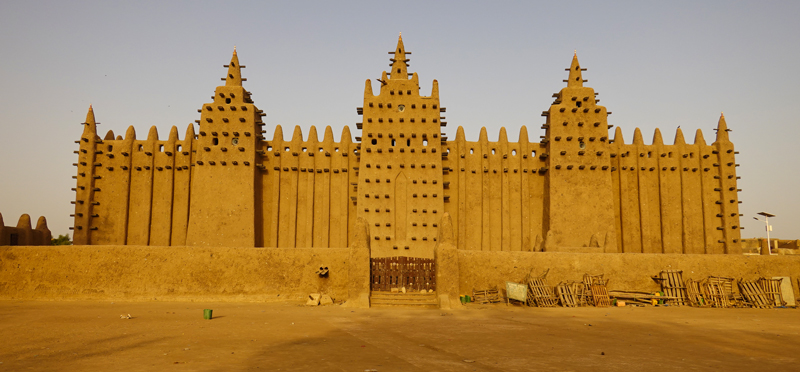
Story and Photography by Craig Thompson
I spent a few months in East Africa several years ago and absolutely loved it. So when an opportunity recently arose to visit West Africa with some friends, I couldn’t pass it up. As I started planning this trip, most of my friends said I was crazy. “Crime was rampant. The accommodation was terrible. Terrorists were everywhere. Food wasn’t edible. The Muslims were not to be trusted…” on and on their list of discouragements went. Well, they got only one item right: the accommodation was terrible!
“Not much English is spoken so ‘Bonjour’, ‘Oui’, and ‘Merci beaucoup’ – the only three French expressions I knew – were of little help…”
The original plan was to visit ten countries over a two-month period, starting in Mauritania and working our way down to the Ivory Coast. Then came Covid-19, so we ended up cutting our trip short and only visiting five countries. But what a trip it was!
Table of Contents
Mauritania: The Starting Point
I started my West Africa trip in Mauritania. Flying in from Bangkok was no easy feat. At the time I left my home in Thailand, the coronavirus was starting to rage across Asia. Everybody at the airport, and across most of Asia, was wearing masks. People were nervous, and I was eagerly looking forward to getting away from the confusion.
“No Covid-19 in West Africa” I reminded myself, so I was excited to start my rendezvous with Africa.
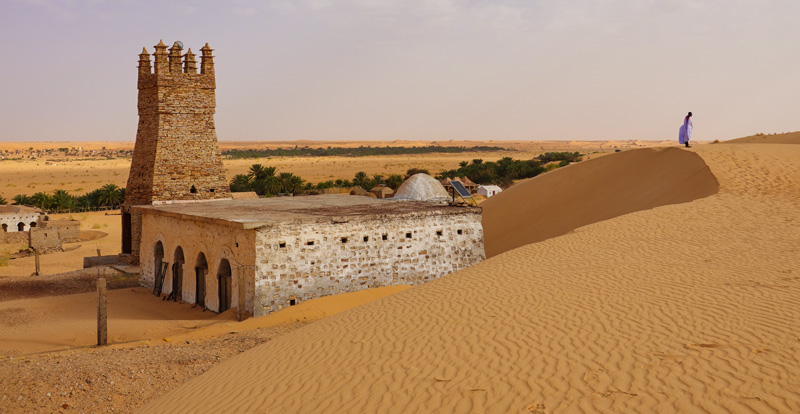
Getting through Customs & Immigration in Mauritania was easy enough though “cash only” was accepted for the visa-on-arrival. But, that came with a policy of “no change” if you didn’t present the exact amount of money!
My tour agency had arranged a taxi, which was waiting for me at the airport. How lucky I was! The airport was out in the middle of nowhere, ATMs weren’t working, and the place was quite deserted at the time I arrived.
No public taxis were waiting to pick up passengers so my pre-arranged taxi was a life-saver.
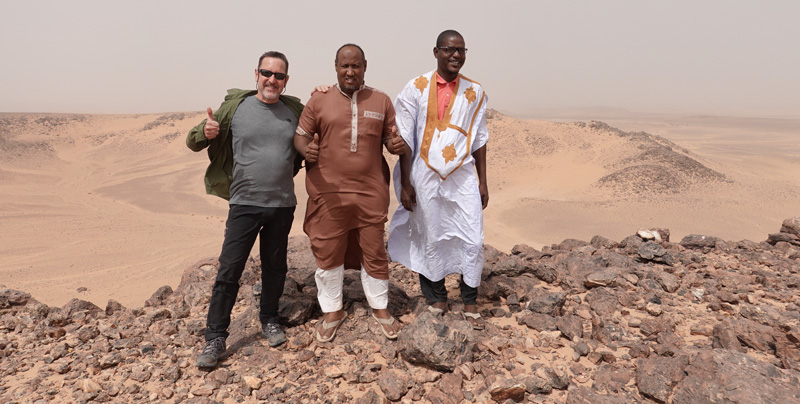
Nouakchott, the Mauritanian capital, is a challenging city, even for us seasoned travellers. Crowded, lots of traffic jams, dirty, and dusty. However, I found the locals to be extremely friendly and helpful.
Not much English is spoken so “Bonjour”, “Oui”, and “Merci beaucoup” – the only three French expressions I knew – were of little help. I was soon to rapidly expand my French vocabulary.
We hired a guide to drive us out to the fish market before we left town for the desert.
There were thousands of fishing boats crewed by men from all over Africa. Most were not from Mauritania and would spend days out at sea in these small boats for their catch.
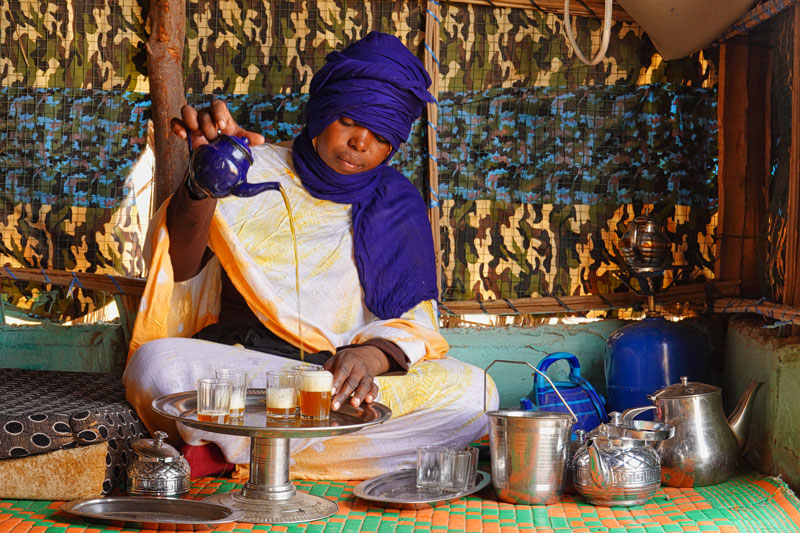
Taking pictures in Muslim countries can be tough. Mauritania is one of the worst and most locals rejected our requests for photos. But, we had fun and got to see a nice sunset over the small harbour. Also amazing were the many boats with their catches.
Mauritania is a “dry” country. Don’t even think of bringing in any booze!
The day after our arrival, we headed into the desert. This is truly an untouched part of the world, so I had high expectations for this part of the trip.
We took off early in the morning in a 4×4 with our driver and guide for our “Four-Day Desert Tour”.
First up was Chinguetti, located over 500 kilometres (310 miles) to the northeast of Nouakchott. Chinguetti was established in 1264 after the original city, built in 777 AD, started to disappear into the desert. The highlight is its famous library, located in the middle of the ruins of the old city. A very animated caretaker told us the history of the library and city and showed us some manuscripts that date back over 500 years.
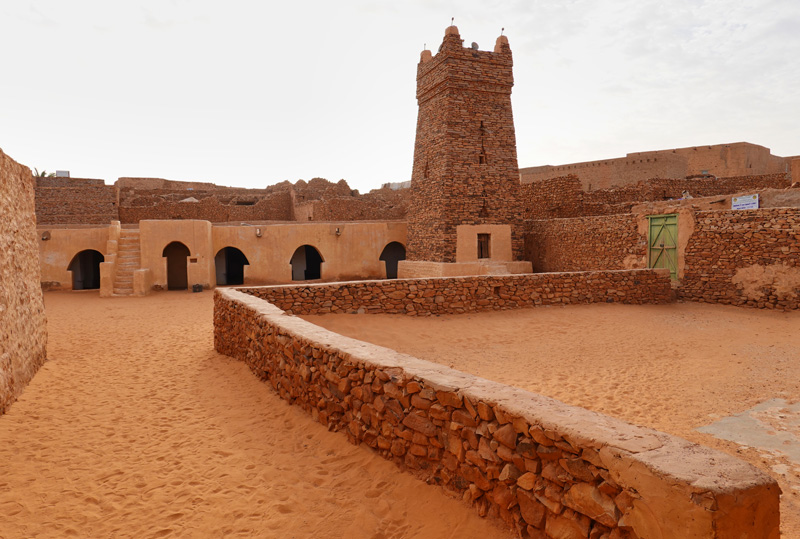
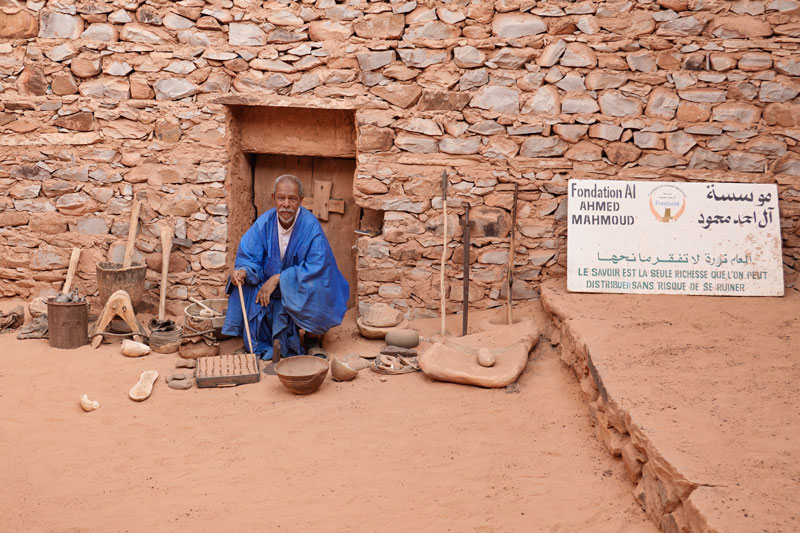
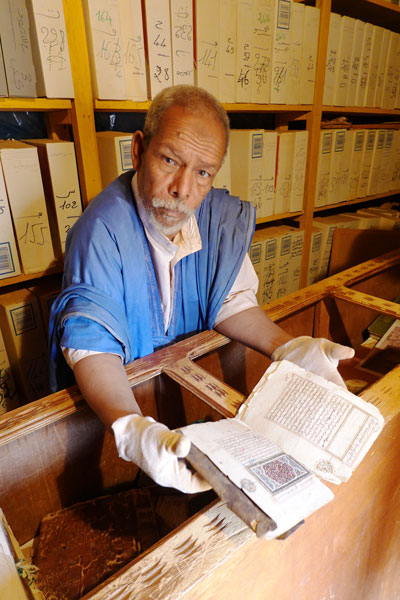
Amazing to think people could build such cities almost 1,000 years ago. It is incredibly beautiful.
Next up was a rough three-hour drive, also in a northeastern direction, to the UNESCO heritage site of Ouadane on the southern edge of the Adrar Plateau.
The ride through the desert scenery was stunning. Parts of the road were very rough and bumpy and almost unbearable in the extremely hot weather. But at the end of the journey, the ancient city of stone was certainly worth the torturous ride.
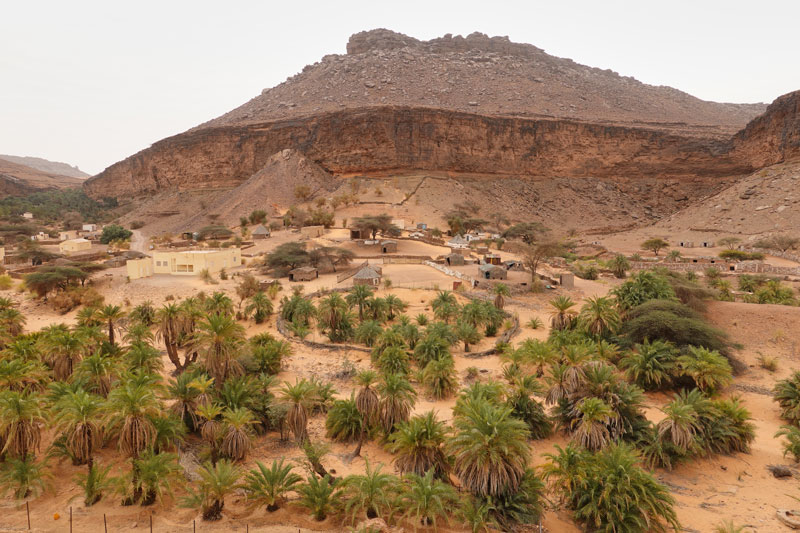
High on a rocky outcrop and surrounded by a beautiful oasis, the setting is quite dramatic. Restorations have been quite meticulous so the city is still in good shape.
The desert journey continued for the next few days and ended up in a small village. Here we had shakshuka, a traditional dish cooked in a tagine pot, with eggs, vegetables and of course, camel meat. This was my first time eating this dish and it was superb.
The drive back to Nouakchott was quite challenging. We encountered a massive sandstorm which reduced our driving speed to just 20 km/h (12 mph). Our driver received all the encouragement he needed from us and kept going even when the visibility was only 10 metres (33 ft), at best. We almost crashed into the back of a truck with no tail-lights but eventually we made it safely to the Nouakchott airport.
As the Mauritania-Senegal border is notoriously difficult to cross, we decided to fly from Nouakchott to Dakar. However, due to the raging sandstorm, we were not sure if the planes could fly. Not surprisingly, our flight was three hours delayed, and we were concerned that it might not be able to take off at all. So, we anxiously waited in a very dusty room for confirmation.
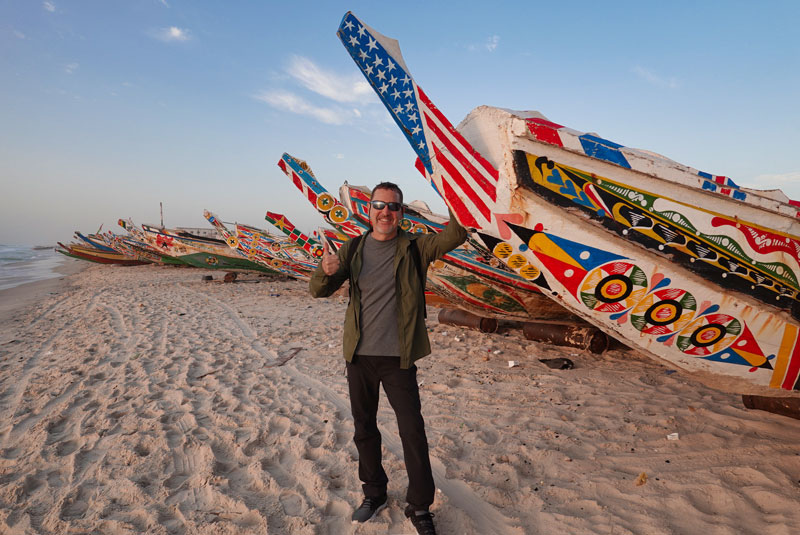
While waiting to board the plane, I decided to use the toilet. I told my travel companion and the lady at the boarding desk that I would be back in a few minutes, and was assured that there would be an announcement when the plane was ready for boarding.
As I got out of the toilet, I saw my plane starting to taxi out. I ran downstairs but just got shrugs from the boarding desk. “Too bad, but no worries, there’s another flight tomorrow”, she tried to comfort me. UGH! With a 45-minute drive outside the city, and a 6 am flight, it wasn’t worth getting to a hotel.
Some helpful airline staff allowed me to sleep in their office, on the floor. At least they gave me a pillow!
No ATMs at the airport were in working order, so I didn’t have money to buy any food, as I had used the last of my emergency cash to buy another plane ticket!
Fortunately, the friendly airline staff took care of me, giving me tea and cookies. Such nice people.
I safely made it to Dakar the next day, more than a bit upset with my travel companion as he should have looked out for me. Oh well, the joys of travel!
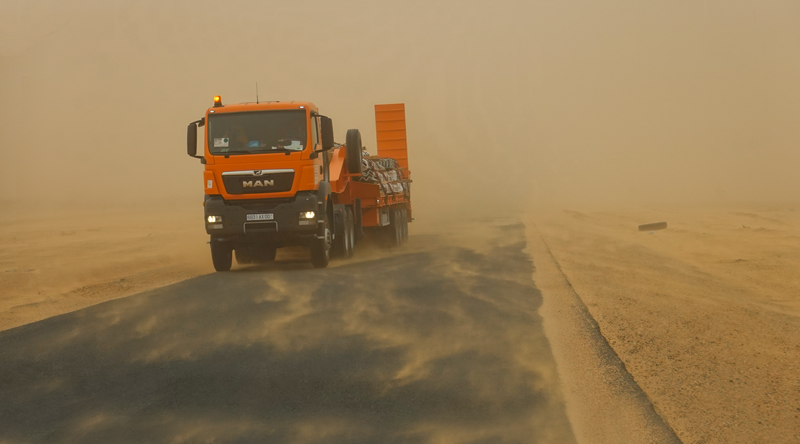
Senegal: A Brief Encounter
The flight to Dakar on the west coast of Senegal went surprisingly well and an easy visa-on-arrival welcomed me into the country. My friend and I met up with our travel companion, Ric Gazarian, a well known travel blogger at globalgaz.com.
I did not find any “must see” sights in Dakar. There are a few islands that are nice, but not much else. So, after two nights, we flew on to Ouagadougou in Burkina Faso.
Burkina Faso: The Pinnacle
A Welcome Entrance
My attempt to get a Burkina Faso tourist visa in Dakar failed, so I tried my luck getting a visa-on-arrival. Both my friends already had their visas, so I was the odd one out without a visa which left me quite worried.
As we arrived in Ouagadougou, capital of Burkina Faso, the airport staff recorded our temperatures and ordered us to fill out their freshly printed Covid-19 screening forms on which we had to indicate where our journey originated.
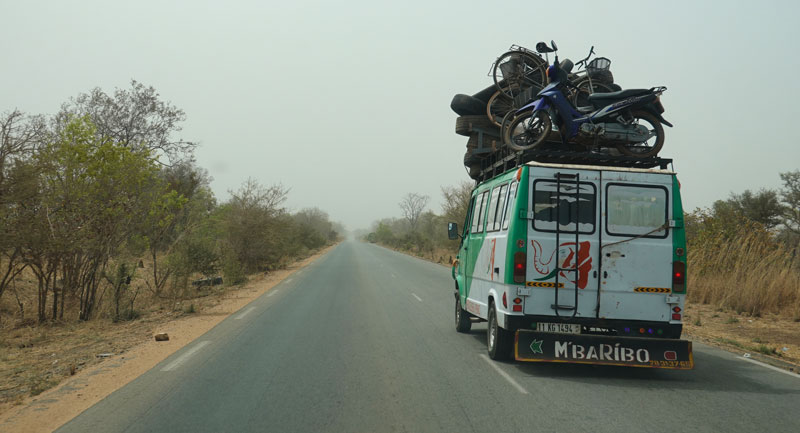
Ric and I were hesitant to admit that we had flown in from Thailand as a few early cases had already been reported there. As we were travelling on our American passports, a country which at that time had almost no cases of Covid-19, we put “USA” on our forms.
We felt quite intimidated by the many armed soldiers in the room, so we were nervous about whether we had made the right decision. Surprisingly, the immigration staff were super nice, joked around, and after a lot of smiling waved us into their country. What a relief.
After a few uneventful days in Ouagadougou, we left for Dédougou, about four hours away by car. At last, we would soon be seeing one of my greatest expectations for the entire trip: The much-hyped Mask Festival of Dédougou.
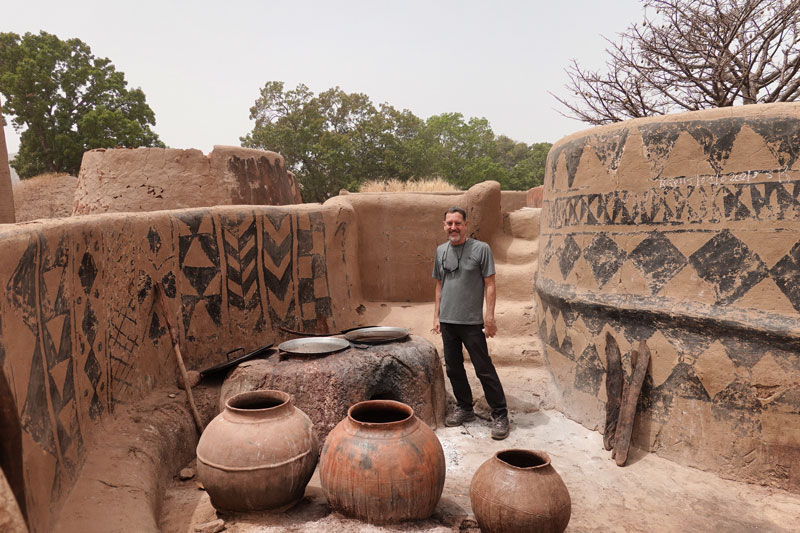
The ride was quite smooth as we had a very capable driver, a good 4×4, and even air conditioning that functioned well enough.
En route, we stopped to visit an alligator park. The insane situation in which we soon found ourselves will always be in my memory – we were surrounded by about 60 alligators, and we were feeding chickens to them!
The park’s guides did their very best to keep the alligators at a safe distance from us by hitting them with sticks. But they are quite sneaky so every now and then I spotted some of them creeping up behind us. However, I overcame my fears and soon I was posing for a photo while sitting on an alligator’s back. What an unforgettable experience it turned out to be!
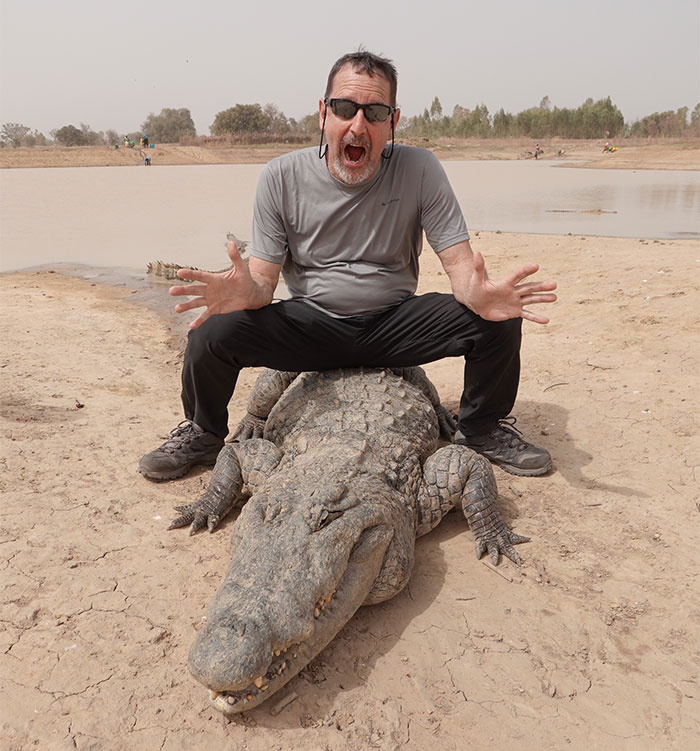
The Famous Mask Festival
The Festival International des Masques et des Arts (International Festival of Masks and the Arts), or FESTIMA, is a biennial festival in the town of Dédougou, celebrating traditional African masks.
The festival was founded to help preserve traditional mask-wearing practices, and features masks and traditions from several West African countries. The masks are primarily used for religious purposes and historically support the animist beliefs of the locals.
While FESTIMA offers seminars on historical and cultural topics, as well as storytelling, competitions, and authentic markets, the highlight of the week-long festival is the dancing of the masked performers accompanied by musicians playing entrancing drums, whistles, and balafons – a type of wooden percussion instrument.
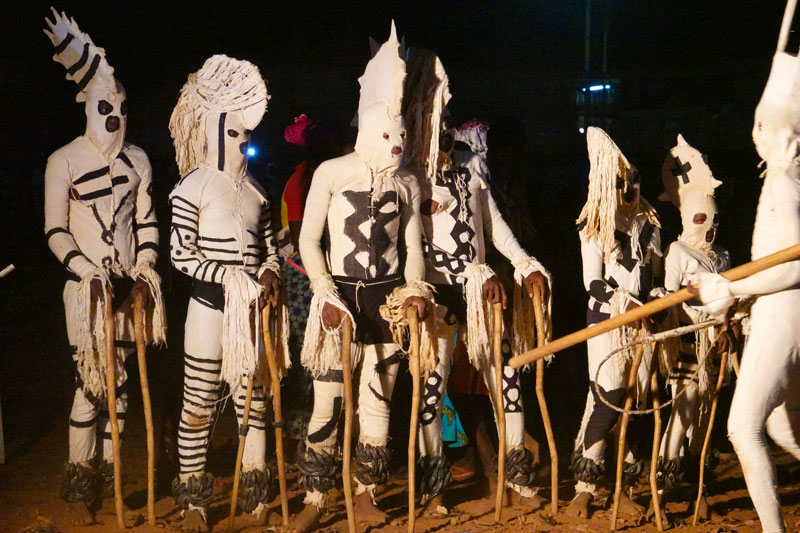
It was unquestionably one of the most colourful and exciting festivals I have ever attended, anywhere.
At the festival, our travelling troupe grew a little bigger as more travellers joined us, including the Thai celebrity blogger and YouTuber known as Mint. Mint blogs under the name “I Roam Alone” and was a great addition with her smiles and wealth of travel tales!
Mint’s shoulder was bothering her, so in line with local customs, we went to find a voodoo medicine man. After much searching, and asking around at the market, we found one! He hailed from the Ivory Coast where voodoo healers are much revered.
He did an intense session with her and determined that a ghost was causing the pain. He even claimed to clearly see the ghost. Mint was rather shocked as she was no lover of ghosts of any kind. The proposed cure? Sacrifice a goat! Not surprisingly, Mint wasn’t into slaughtering goats either, so she turned down the cure. In addition to saving the life of the goat, she also saved the $100 it would have cost her to first buy it.
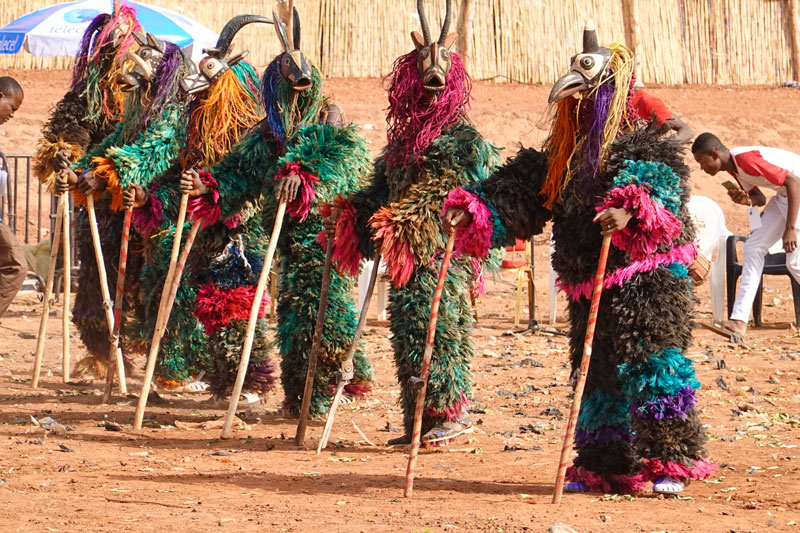
The next day we were up early as the first parade started at 8:30 with the main event getting under way at around 9:30. What a parade it was! The masks were stunning and the dancers even more impressive. There were about five groups dancing in the parade, each wearing their own distinctive masks. A parade to not easily forget.
But it seemed that the sketchy security situation in Burkina Faso, with the risk of terrorism, armed criminality, and kidnapping, had scared off not only the tourists but also some performers. Several groups had decided not to attend.
With some concerns for our own security, we altered our itinerary somewhat and headed 180 kilometres (112 mi) southwest to Bobo-Dioulasso for a night, and then continued further southwest to see the wildlife, waterfalls, lakes, and mountain peaks of Park National du Sindou in Banfora.
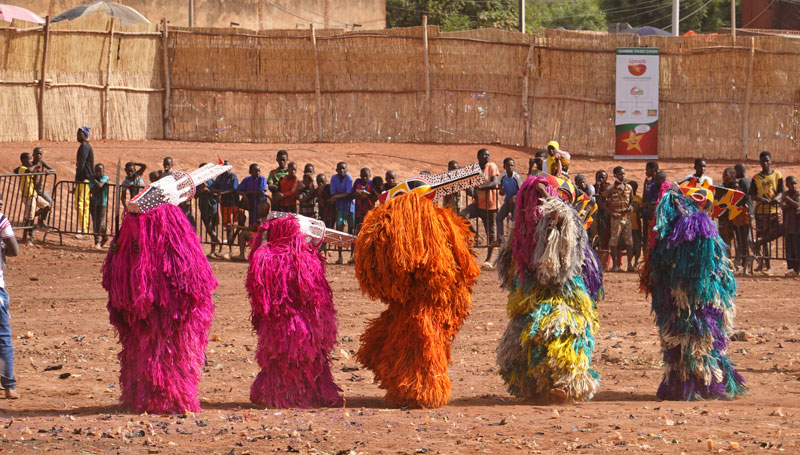

Mali – Here We Come!
All along we were well aware that our most challenging destination would be Mali, especially as the website of the US Department of State screams in red ink: “MALI TRAVEL WARNING: Do not travel to Mali due to crime, terrorism, and kidnapping”.
Mali, here we come!
If we avoid all destinations because of such warnings, we would not travel anywhere, so off we went to Mali to meet the dodgiest part of our entire trip head-on.

Our next destination, Djenné, located in south-central Mali, is a 473 kilometre (294 mi) drive due north of Banfora. Along this route we decided to spend our last night in Burkina Faso in the town of Bobo-Dioulasso—an 85 kilometre (53 mi) drive northeast of Banfora.
The main point of interest in Djenné is the famous mud temple, more appropriately referred to as the Great Mosque of Djenné, located smack in the middle of the NO-GO zone. En route, we passed several military checkpoints, but luckily they all just waved us through.
The town had been under attack by ISIS and al-Qaeda loyalists just a few months before our arrival. The Mali army was afraid to take on the invaders so the locals called upon a group of hunters who roamed around the area for help. It worked, and they staved off the attackers.
The situation was still volatile at the time of our arrival, so we were quite concerned. The local security forces only allowed us a one-night stay in the sole hotel approved for foreigners.
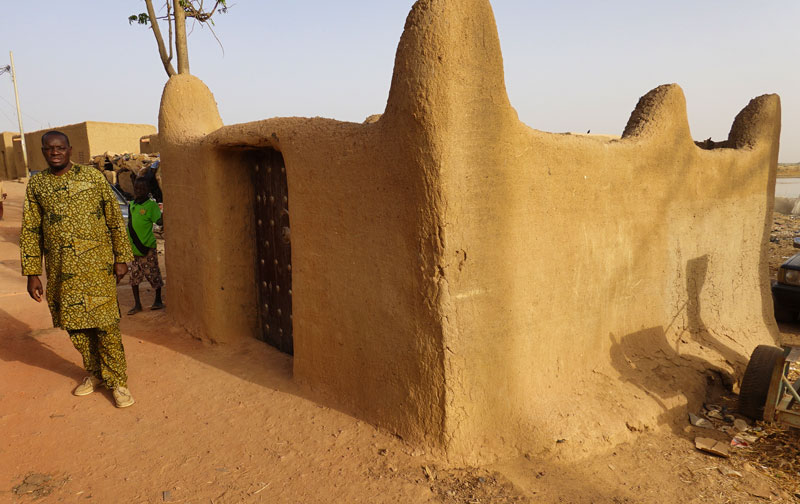
During our overnight stay the taps were mostly dry, though the people were friendly. The buildings are built in the Sudanese style, with fascinating facades, and of course, filled with locals going about their daily activities. Amazing sights and sounds!
Djenné consists entirely of mud structures created from traditional adobe mixtures of cow dung, sand, rice husks, dried weeds, and even old plastic bags. By default, an environmentally friendly practice as old as the mountains!
Malians fabricate bricks out of these materials, build the structures, and then render them over with muddy water to make it look nice. “Nice” may not be the right word, but it sure looks interesting and unique.
The Great Mosque of Djenné is the biggest mud-brick-mosque (more correctly cow-dung-brick-mosque) in the world, able to accommodate 2,000 worshippers at a time. Due to their increasing reliance on tourist dollars, the mosque nowadays allows non-Muslims to enter, for a fee.
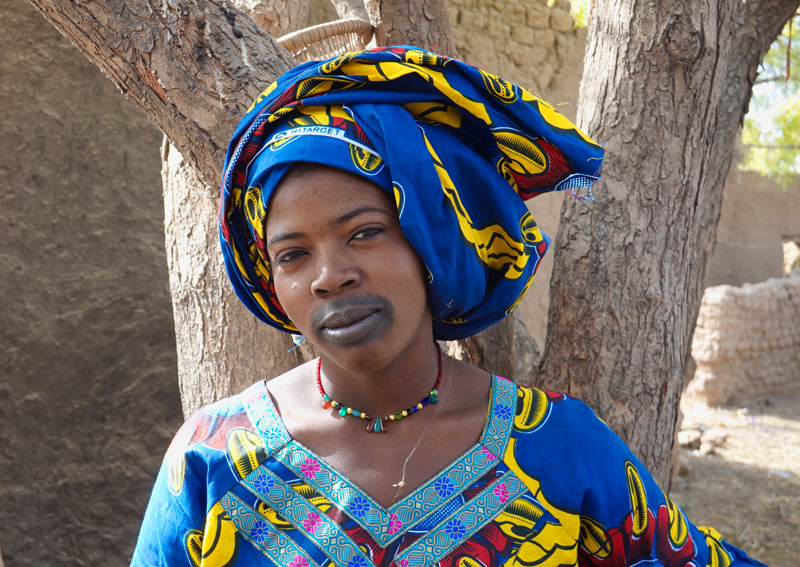
The mosque’s interior is enormous and its central tower is about 16 metres (52 ft) high. Even though foreign Muslim investors have offered to tile its floors, today the sand floors remain. Large carpets are laid out on the sand on which the faithful pray. We climbed the stairs to the roof for some magnificent views over the mud city.
After a nail-biting 24 hours in Djenné, we headed 550 kilometres (342 mi) southwest to the Mali capital, Bamako. Along the way we stopped at a small village inhabited by the Fulani tribe, one of the largest ethnic groups in West Africa.
They are a Muslim tribe and are considered to be quite fierce. Even the terrorists live in fear of the Fulani, as they are one of the tribes currently involved in local conflicts. The Fulani women are famous for the tattoos around their lips, an adornment which is highly admired by the men.
The main reason for stopping in this village was that the family we visited owned a spectacular collection of jewellery handed down for many generations. The matriarch of the household dressed up for us in her traditional attire and what a show it was. She even wore huge earrings made with pure gold.
After a very entertaining time with the Fulani family, we continued our drive to Bamako.

Back in Senegal
From Bamako, it is a two-day drive (1,600 km / 994 mi) back to Dakar in Senegal. Too far for our tired bodies, so we decided to fly and reunite with our vehicle and driver in Dakar.
The flight went smoothly and from Dakar we drove 230 kilometres (145 mi) north to just south of the border with Mauritania, where we stayed in the coastal town of St. Louis.
While St. Louis and its beaches were of some interest, the big attraction here is the Djoudj National Bird Sanctuary, located 60 kilometres (37 mi) north of town. Another incredible experience with thousands of pelicans literally everywhere, completely surrounding us, and flying over our heads. Totally awesome!
We spent the night in St. Louis and at daybreak we headed south, past Dakar, for over 360 kilometres (224 mi) to the border with The Gambia. We came this far just to visit the Fathala Wildlife Reserve.
The night in a luxurious tented camp in the middle of a private game preserve was quite expensive, but what an experience it was.
We saw zebras, waterbucks, warthogs, antelopes, giraffes, a white rhino and more. The most incredible moment was having a personal, up close encounter with the lions. So close, that I even posed right next to them.
It was quite scary being just a few inches away from an animal that could easily devour us for lunch. Fortunately the handlers were quite professional, so we were confident of being in capable hands! And we lived to tell the tale…
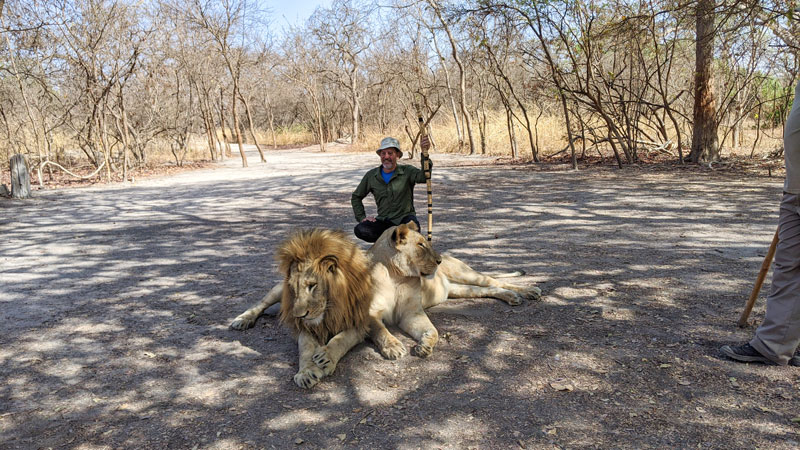
Covid-19 And The Gambia
And then it happened: Rumours started swirling around in our camp that the local borders may be closing due to the coronavirus. Not only that, but borders were also closing around the world, and that we had better keep a close eye on how the situation was unfolding in West Africa.
Without thinking too much, we decided to cross into The Gambia and then take a boat to Banjul, our nearest international airport, from where we hopefully could fly out of the region. Fortunately, we were only about 5 kilometres (3 miles) from the border crossing.
The ferry ride on the River Gambie to Banjul was no walk in the park. We waited in line for three hours just to board, and as usual in Africa, it was very chaotic with hundreds of people all trying to board at the same time. The crowded ferry was no love-boat sailing!
We heard that Morocco had announced a complete closure of all their borders and halted all international flights. Mali, Mauritania and South Africa had done the same a few days earlier, along with several other African countries.
We could sense the walls closing in on us. We had better get out of West Africa soon, or be prepared to be stuck here for a long while.
Over dinner in Banjul, we decided to buy tickets on Turkish Airlines to fly to Istanbul the next day. At the airport, we found out that we were on the last Turkish Airlines flight out of The Gambia. The flight was packed with people.
Our biggest fear was not actually getting the virus, but being stuck in a third world country for who knows how long. Should the virus get out of hand, it could literally be hell, as these poor countries have very inadequate health care services and facilities.
Our next destinations were supposed to have been Guinea-Bissau, Guinea, Sierra Leone, Liberia, and the Ivory Coast. However, there was no way we could continue our journey with the Covid-19 threat hanging over our heads. There were too many unknowns, and the risks too high.
So, off we flew into the sunset and landed safely in Istanbul from where I continued on to Thailand and landed just before international arrivals were blocked for many months to come.
I was more than relieved when I safely arrived in my home and could once again enjoy the tasty Thai food with a frosty glass of white wine!
Final Thoughts On West Africa
As I’ve experienced many times in my life, travel opens your mind and changes your perception of the world. This West Africa trip radically enhanced mine.
West Africa is a fantastic place to visit and not nearly as dangerous as the warnings many people gave me suggested. The vast majority of its people are kind, honest and giving. For example, I was sitting on the plane next to a young man from the region who offered me some of his food in case I didn’t get enough to eat.
Also, when I paid too much for a bottle of water at a small hole-in-the-wall shop in Senegal, the cashier unexpectedly gave me back the extra money. This actually happened several times during our trip.
When I missed my flight in Mauritania, the airline staff gave me bread and tea, and even a pillow, so I could get some sleep on their couch.
Everywhere we went, we were treated with kindness and respect. It is remarkable considering that most people here own very little. Although incredibly poor, they are honest and have good hearts. In most of the places we went, we were the only white people – a few specks of salt in a sea of pepper.
I’ve had more bad experiences travelling in Europe than I’ve had in Africa. While in West Africa the infrastructure sucks, food can be dodgy, tap water is not potable, and hotels are sub-standard, the people are good-hearted and do the best with the little that they have.
I can’t wait to get back and continue my West Africa odyssey!

☛ Read more: Posts of Africa


